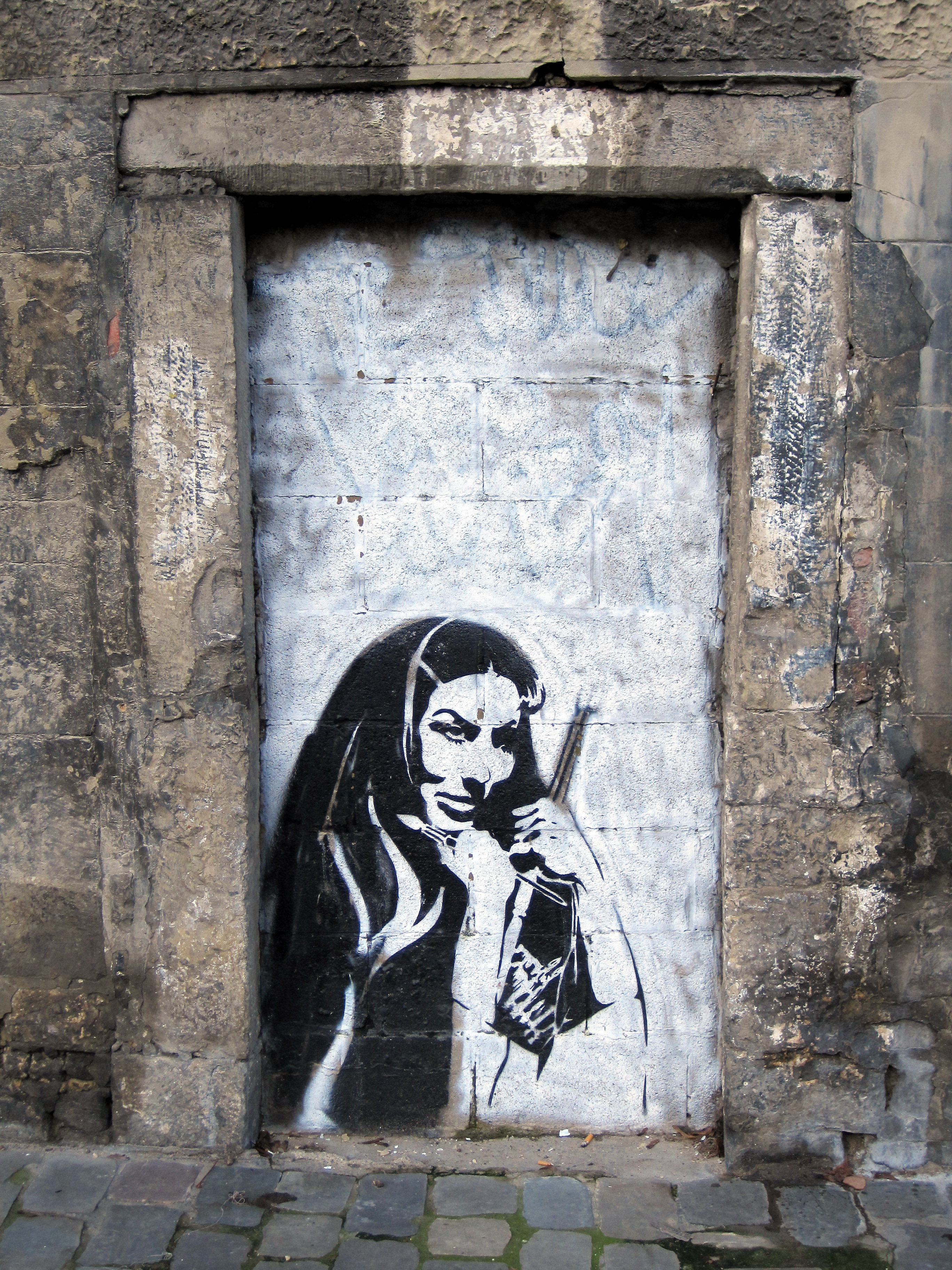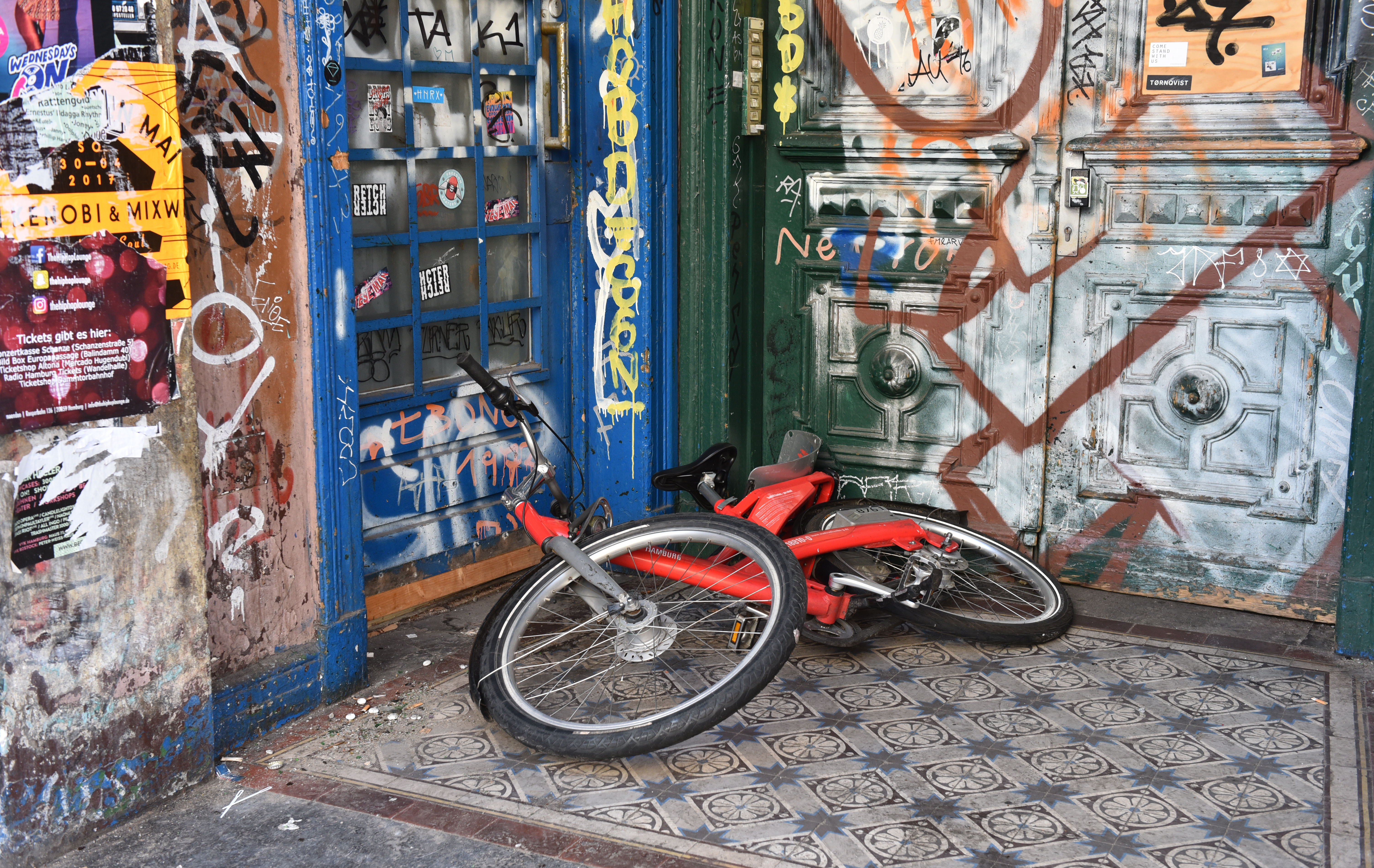|
Graffiti
Graffiti (singular ''graffiti'', or ''graffito'' only in graffiti archeology) is writing or drawings made on a wall or other surface, usually without permission and within public view. Graffiti ranges from simple written "monikers" to elaborate wall paintings, and has existed since ancient times, with examples dating back to ancient Egypt, ancient Greece, and the Roman Empire. Modern graffiti is a controversial subject. In most countries, marking or painting property without permission is considered vandalism. Modern graffiti began in the New York City subway system and Philadelphia in the early 1970s and later spread to the rest of the United States and throughout the world. Etymology "Graffiti" (usually both singular and plural) and the rare singular form "graffito" are from the Italian word ''graffiato'' ("scratched"). In ancient times graffiti were carved on walls with a sharp object, although sometimes chalk or coal were used. The word originates from Greek —''gr ... [...More Info...] [...Related Items...] OR: [Wikipedia] [Google] [Baidu] |
Street Art
Street art is visual art created in public locations for public visibility. It has been associated with the terms "independent art", "post-graffiti", "neo-graffiti" and guerrilla art. Street art has evolved from the early forms of defiant graffiti into a more commercial form of art, as one of the main differences now lies with the messaging. Street art is often meant to provoke thought rather than rejection among the general audience through making its purpose more evident than that of graffiti. The issue of permission has also come at the heart of street art, as graffiti is usually done illegally, whereas street art can nowadays be the product of an agreement or even sometimes a commission. However, it remains different from traditional art exposed in public spaces by its explicit use of said space in the conception phase. Background Street art is a form of artwork that is displayed in public on surrounding buildings, on streets, trains and other publicly viewed surfaces. M ... [...More Info...] [...Related Items...] OR: [Wikipedia] [Google] [Baidu] |
Commercial Graffiti
Commercial graffiti (also known as aerosol advertising or graffiti for hire) is the commercial practice of graffiti artists being paid for their work. In New York City in particular, commercial graffiti is big business and since the 1980s has manifested itself in many of the major cities of Europe such as London, Paris and Berlin. Increasingly it has been used to promote video games and even feature prominently within them, reflecting a real life struggle between street artists and the law. Commercial graffiti has created significant controversy between those who view it as an effective medium of advertising amongst specific target audiences and those who believe that legal graffiti and advertising using it encourages illegal graffiti and crime. History Graffiti as a commercial activity dates back to Ancient Greece, when pottery makers employed artists to decorate their items with motifs and intricate designs. The modern era, the phenomenon has been strongly associated with New Y ... [...More Info...] [...Related Items...] OR: [Wikipedia] [Google] [Baidu] |
Stencil Graffiti
Stencil graffiti is a form of graffiti that makes use of stencils made out of paper, cardboard, or other media to create an image or text that is easily reproducible. The desired design is cut out of the selected medium and then the image is transferred to a surface through the use of Aerosol paint, spray paint or roll-on paint. The process of stencilling involves applying paint across a stencil to form an image on a surface below. Sometimes multiple layers of stencils are used on the same image to add colors or create the illusion of Three-dimensional space, depth. Stencils can be done quickly. Together with being cheap and easily repeatable, the short amount of time required to paint a single stencil illegally onto a wall is a key characteristic that makes stenciling attractive. History Stencil graffiti as an art form began in the 1960s. Today it is usually a part of Street Art, in style writing graffiti stencils are not used much or their use is often disguised or not val ... [...More Info...] [...Related Items...] OR: [Wikipedia] [Google] [Baidu] |
1UP (graffiti Crew)
1UP (One United Power) is a graffiti crew from Berlin, Kreuzberg. They have been active since 2003. 1UP have been described as "one of the most well-known graffiti crews in the world" and are known for their bombing (large amount of tags put up in one night), rooftop paintings, and wholecar, wholetrains . Members There are between 10 and 50 members, of different genders, with ages ranging from 20-40. The members are not all German, they come from various European countries. All of the members are anonymous, and some do not do solo graffiti, preferring only to tag as 1UP. The group has had over 300 criminal charges filed against them, but none of the members have been caught so far. Publications Their film ''One United Power'' was released in 2011 on DVD, and their book ''I Am 1UP'' published in 2014. In 2018 1UP collaborated with graffiti photographer Martha Cooper as part of their ''One Week With 1UP'' tour. A book about the tour was published by Cooper under the same nam ... [...More Info...] [...Related Items...] OR: [Wikipedia] [Google] [Baidu] |
Tag (graffiti)
Tags are one of the primary forms of modern graffiti, along with Throw up (graffiti), throw ups and Piece (graffiti), pieces. The act of writing a tag is known as tagging. Tags are often thought of as the simplest form of graffiti art, prioritising legibility and flow, and are the form that most artists start with. Tags, perhaps due to their simplicity, are more likely to be considered vandalism than other more elaborate graffiti styles. Tags are an artist signature and vary through uniqueness and methods. Form Often produced using spray paint or Permanent marker, markers, tags are established from throw-up and pieces. They are two-dimensional, often smaller in size, and with thinner lines reflecting the need for quick execution due to the often illegal nature of tagging. This necessity for speed has led to tags which are written in a single stroke called one-liners. While throw-ups and pieces may be formed from any word or even a sentence, a tag functions similarly to a signat ... [...More Info...] [...Related Items...] OR: [Wikipedia] [Google] [Baidu] |
Hip Hop (culture)
Hip-hop culture is an art movement that emerged in New York City, in the borough of The Bronx; Primarily within the black community. Hip Hop as an art form and culture has been heavily influenced by both male and female artists. It is characterized by the key elements of rapping, Disc jockey, DJing and turntablism, and breakdancing; other elements include graffiti, beatboxing, street entrepreneurship, hip hop language, and hip-hop fashion. Many cite Hip Hop's emergence as beginning in August 1973 when brother–sister duo DJ Kool Herc and Cindy Campbell hosted the first documented indoor hip hop party and culture event in the Bronx; Helping to spark the rise of the genre. However many hiphop pioneers and historians contend that Hip Hop did not have just one founding father. The black Spades street gang and Disco King Mario, Disco king Mario of the Bronxdale Houses are also considered a vital part in the early origins of Hip Hop culture and music. As Disco King Mario was hostin ... [...More Info...] [...Related Items...] OR: [Wikipedia] [Google] [Baidu] |
TAKI 183
TAKI 183 is the "tag" of a Greek-American graffitist who was active during the late 1960s and early 1970s in New York City. The graffitist, whose given name is Demetrios, has never revealed his full name. Biography TAKI 183 was a graffiti tagger active during the late 1960s and early 1970s in New York City. His tag was short for "Dimitraki", an alternative for his Greek birth-name Dimitrios, and the number 183 came from his address on 183rd Street in Washington Heights. He worked as a foot messenger in New York City and would write his nickname around the streets that he frequented. On July 21, 1971, ''The New York Times'' published an article about him titled ''"Taki 183" Spawns Pen Pals.'' TAKI 183 spurred hundreds of imitators including Joe 136, BARBARA 62, EEL 159, YANK 135 and LEO 136 as examples provided by the newspaper. Those who got their names up the most and who developed signature tags became known in their communities. Graffiti became a way for many young people t ... [...More Info...] [...Related Items...] OR: [Wikipedia] [Google] [Baidu] |
Cornbread (graffiti Artist)
Darryl McCray (born 1953), better known by his tagging name Cornbread, is an American graffiti writer from Philadelphia. He is widely considered one of the world's first modern graffiti artists. McCray was raised in Brewerytown, a neighborhood of North Philadelphia. During the late 1960s, he and a group of friends started doing graffiti in Philadelphia, by writing their monikers on walls across the city. Independently to Philadelphia, the graffiti movement was evolving in New York City and blossomed into the modern graffiti movement, which reached its peak in the U.S. in the late 1970s and early 1980s, and then spread to Europe. McCray later worked with the Philadelphia's Anti-Graffiti Network and Mural Arts Program to help combat the spread of graffiti in the city. He is currently a public speaker and a youth advocate. Childhood and corrections facility Born in Brewerytown, Philadelphia in 1953, Darryl McCray was primarily raised by his mother and grandparents. In 1965, ... [...More Info...] [...Related Items...] OR: [Wikipedia] [Google] [Baidu] |
Graffito (archaeology)
A graffito (plural "graffiti"), in an archaeological context, is a deliberate mark made by scratching or engraving on a large surface such as a wall. The marks may form an image or writing. The term is not usually used for the engraved decoration on small objects such as bones, which make up a large part of the art of the Upper Paleolithic, but might be used for the engraved images, usually of animals, that are commonly found in caves, though much less well known than the cave paintings of the same period; often the two are found in the same caves. In archaeology, the term may or may not include the more common modern sense of an "unauthorized" addition to a building or monument. Sgraffito, a decorative technique of partially scratching off a top layer of plaster or some other material to reveal a differently colored material beneath, is also sometimes known as "graffito". Categories The basic categories of graffiti in archaeology are: *Written graffiti, or informal inscr ... [...More Info...] [...Related Items...] OR: [Wikipedia] [Google] [Baidu] |
Vandalism
Vandalism is the action involving deliberate destruction of or damage to public or private property. The term includes property damage, such as graffiti and defacement directed towards any property without permission of the owner. The term finds its roots in an Enlightenment view that the Germanic Vandals were a uniquely destructive people, as they sacked Rome in 455 AD. Etymology The Vandals, an ancient Germanic people, are associated with senseless destruction as a result of their sack of Rome under King Genseric in 455. During the Enlightenment, Rome was idealized, while the Goths and Vandals were blamed for its destruction. The Vandals may not have been any more destructive than other invaders of ancient times, but they did inspire English poet John Dryden to write, ''Till Goths, and Vandals, a rude Northern race, Did all the matchless Monuments deface'' (1694). However, the Vandals did intentionally damage statues, which may be why their name is associated with ... [...More Info...] [...Related Items...] OR: [Wikipedia] [Google] [Baidu] |
Urban Art
Urban art combines street art, guerrilla art, and graffiti and is often used to summarize all visual art forms arising in urban areas, being inspired by urban architecture or present urban lifestyle. Because the urban arts are characterized by existing in the public space, they are often viewed as vandalism and destruction of private property. Although urban art started at the neighborhood level, where many people of different cultures live together, it is an international art form with an unlimited number of uses nowadays. Many urban artists travel from city to city and have social contacts all over the world. The notion of 'Urban Art' developed from street art which is primarily concerned with graffiti culture. Urban art represents a broader cross-section of artists that, in addition to covering traditional street artists working in formal gallery spaces, also cover artists using more traditional media but with a subject matter that deals with contemporary urban culture and polit ... [...More Info...] [...Related Items...] OR: [Wikipedia] [Google] [Baidu] |
Moniker (graffiti)
Monikers (also known as streaks, tags, or hobo art) are a type of graffiti done on the side of a freight car on freight trains. They date back to the late 1800s. Monikers are usually produced with a solid paint stick, industrial crayon, or a lumber crayon. Monikers serve the purpose for a moniker artist to share stories or a moment in time with others. Monikers are usually basic line drawings and may include a name and date. Many moniker artists have a unique design they produce, and sometimes write the area they are from, or date that the moniker was produced. Occasionally, a short phrase will accompany monikers (this being started by BuZ blurr, famous for his BuZ blurr#Colossus of Roads, Colossus of Roads moniker). Most of the earliest artists were Hobo, hobos and railroad workers, but since the emergence of modern graffiti in the 1960s, railroad enthusiasts and graffiti writers also use monikers. References * * * •Gastman, Roger and Neelon, Caleb. The History of America ... [...More Info...] [...Related Items...] OR: [Wikipedia] [Google] [Baidu] |









